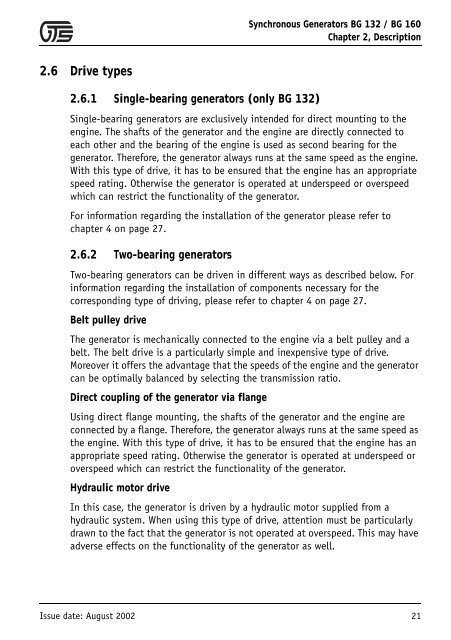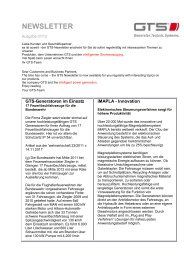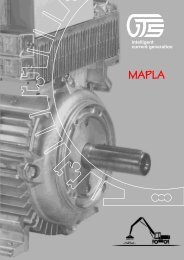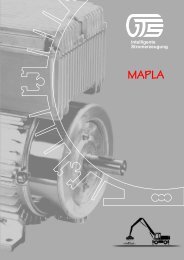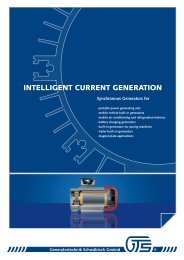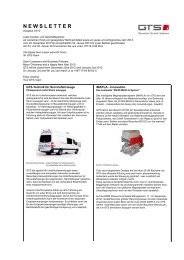Synchronous Generators BG 132 and BG 160
Synchronous Generators BG 132 and BG 160
Synchronous Generators BG 132 and BG 160
Create successful ePaper yourself
Turn your PDF publications into a flip-book with our unique Google optimized e-Paper software.
<strong>Synchronous</strong> <strong>Generators</strong> <strong>BG</strong> <strong>132</strong> / <strong>BG</strong> <strong>160</strong><br />
Chapter 2, Description<br />
2.6 Drive types<br />
2.6.1 Single-bearing generators (only <strong>BG</strong> <strong>132</strong>)<br />
Single-bearing generators are exclusively intended for direct mounting to the<br />
engine. The shafts of the generator <strong>and</strong> the engine are directly connected to<br />
each other <strong>and</strong> the bearing of the engine is used as second bearing for the<br />
generator. Therefore, the generator always runs at the same speed as the engine.<br />
With this type of drive, it has to be ensured that the engine has an appropriate<br />
speed rating. Otherwise the generator is operated at underspeed or overspeed<br />
which can restrict the functionality of the generator.<br />
For information regarding the installation of the generator please refer to<br />
chapter 4 on page 27.<br />
2.6.2 Two-bearing generators<br />
Two-bearing generators can be driven in different ways as described below. For<br />
information regarding the installation of components necessary for the<br />
corresponding type of driving, please refer to chapter 4 on page 27.<br />
Belt pulley drive<br />
The generator is mechanically connected to the engine via a belt pulley <strong>and</strong> a<br />
belt. The belt drive is a particularly simple <strong>and</strong> inexpensive type of drive.<br />
Moreover it offers the advantage that the speeds of the engine <strong>and</strong> the generator<br />
can be optimally balanced by selecting the transmission ratio.<br />
Direct coupling of the generator via flange<br />
Using direct flange mounting, the shafts of the generator <strong>and</strong> the engine are<br />
connected by a flange. Therefore, the generator always runs at the same speed as<br />
the engine. With this type of drive, it has to be ensured that the engine has an<br />
appropriate speed rating. Otherwise the generator is operated at underspeed or<br />
overspeed which can restrict the functionality of the generator.<br />
Hydraulic motor drive<br />
In this case, the generator is driven by a hydraulic motor supplied from a<br />
hydraulic system. When using this type of drive, attention must be particularly<br />
drawn to the fact that the generator is not operated at overspeed. This may have<br />
adverse effects on the functionality of the generator as well.<br />
Issue date: August 2002 21


